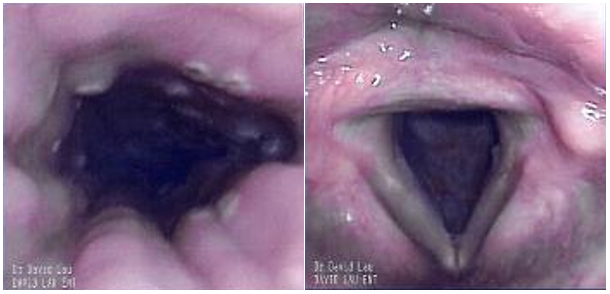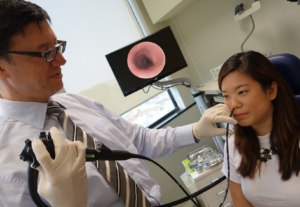Why will I need TNE?
TNE is the examination of the upper gastrointestinal tract including the pharynx, esophagus and stomach, using a thin diameter flexible camera (known as an endoscope) passed through the nose.
It is distinguishable from two other similar examinations which are: (1) trans-oral flexible upper gastrointestinal endoscopy, usually referred to as esophago-gastro-duodenoscopy or OGD, and (2) trans-oral rigid esophagoscopy. The primary advantage of TNE over the two other examinations is that patients undergoing TNE do not require sedation or general anesthetic. This in turn results in a reduced hospital stay and shorter procedure time.
Why will I need TNE?
One of the main reasons for requiring TNE is unexplained throat symptoms. Problems in the esophagus sometimes only present with throat symptoms, which is why examining the esophagus can be important. Such symptoms include unexplained discomfort or pain in the throat that does not go away, or there may be a feeling of a lump in the throat, or a sensation of food sticking in the throat or behind the chest during swallowing. Examination of the throat and neck is usually required before proceeding to TNE.

Yeast infection of the esophagus seen with TNE (white patches in left picture). The patient presented with throat symptoms had a normal looking throat (right picture)
TNE can also be performed to assess the esophagus in patients with gastroesophageal reflux disease (GERD). GERD can damage the lining of the lower esophagus, resulting complications such as pain and difficulty swallowing. Sometimes there can even be changes leading to cancer. GERD can also cause throat symptoms including discomfort, hoarseness and cough, which can occur even without symptoms in the esophagus. Esophagoscopy can identify features such as a hiatus hernia in which the valve at the lower end of the esophagus is faulty, making it easier for acid reflux to occur.
Another reason for performing TNE is to diagnose patients with suspected head and neck cancer, firstly to provide a way to biopsy a suspected growth in the lower part of the throat without requiring general anesthesia, and secondly to screen the esophagus. Screening the esophagus is important because between 10 to 17% of patients with head and neck cancer also have cancer in the esophagus. TNE provides excellent visualisation of the lining of the esophagus and is able to pick up early cancers.
TNE is also useful to examine the esophagus in patients with a suspected foreign body that is stuck. TNE allows a very clear view inside the esophagus. Sometimes the foreign body can be removed using TNE but larger foreign bodies may require a procedure under general anesthetic.
Certain other procedures can be performed using TNE. One example is the insertion of a speaking valve between the windpipe and esophagus to enable speech in patients who have undergone surgery to remove the voice box, usually for cancer. The procedure is known as a tracheo-esophageal puncture, and TNE currently provides probably the most accurate method of placing the speaking valve, with the procedure performed fully under local anesthesia.
Another procedure where TNE is useful is guiding the insertion of a balloon to dilate the upper esophagus when excessive tightness in this region causes difficulty swallowing. Such tightness can be due to scarring from previous radiotherapy or surgery, and it can also result from spasm due to neurological causes.
What should I expect during TNE?
TNE is performed in the office setting under local anesthesia. Before the procedure it is advisable not to eat or drink for at least 4 hours so that the stomach is empty at the time of the examination. Local anesthetic is sprayed into the nose and throat and you will be asked wait a while for the anesthetic to take effect. After this the endoscope is passed through the nose into the back of the throat. Here you will be asked to swallow, which opens the passage from throat to esophagus, so that the endoscope can be passed easily into the esophagus. At the lower end of the esophagus you may be asked to sniff in and hold your breath for a couple of seconds. This allows the relationship between different structures at the lower esophagus (an area known as the lower esophageal sphincter) to be examined in more detail. Next, the endoscope is passed into the stomach and different parts of the stomach can be examined. Inside the stomach the endoscope is turned to look back at itself so that valve where the endoscope enters the stomach can be examined. Biopsies may also be taken from the stomach to test for infection by a bacteria known as Helicobacter Pylori. The biopsies are not painful and are taken by passing a 2-mm forceps on a fine cable through the endoscope. The whole examination takes several minutes to complete.
Is it uncomfortable and what are the risks?
TNE is generally well tolerated and safe. There are some areas of discomfort that should be expected including pressure in the nose and discomfort in the throat due to the presence of the endoscope. There will also be a feeling of bloating due to air being pumped through the endoscope, which is necessary to distend the esophagus and stomach to enable the lining to be seen clearly. Usually these sensations are mild and tolerable once they are expected. Following the examination the throat will feel numb due to the anesthetic. This sensation may last up to an hour or two, and it is important to avoid very hot food or drink during this period to avoid accidentally burning the throat, and also to eat or drink slowly so as not to choke.
Serious complications during TNE are very rare. The most common complications are minor nose bleeds and fainting, which occur approximately between 1 and 4% of the time and usually recover quickly without specific treatment. Compared to conventional trans-oral flexible upper gastrointestinal endoscopy, TNE is considered to be a safer examination as it avoids use of intravenous sedation which accounts for most of the complications with conventional endoscopy. Patients who have experienced both procedures usually prefer the TNE.
Are there alternatives?
Depending on the reason for performing TNE, there may be alternative examinations available. The esophagus can also be examined using x-ray studies although direct examination with endoscopy provides a clearer view of the internal lining and allows biopsies to be taken where necessary.
Two other similar examinations also enable direct visualisation of the inside of the esophagus. These include (1) trans-oral flexible upper gastrointestinal endoscopy, sometimes referred to as esophago-gastro-duodenoscopy or OGD, and (2) trans-oral rigid esophagoscopy. The primary advantage of TNE over the two other examinations is that patients undergoing TNE do not require sedation or general anesthetic.
In certain situations other examinations can provide better information than TNE. The first is if the small intestine needs to be visualised. Typically TNE can reach the stomach but not the small intestine, and if the small intestine requires examination then a full esophago-gastro-duodenoscopy will be needed. The second situation is if motility (or muscle function in the esophagus wall) needs to be examined. In this situation, x-ray studies or pressure studies in the esophagus may be better. Although in TNE, because the patient is fully awake and able to swallow, some information about the muscle function can be obtained.
There are no absolute contraindications to TNE, although if you are taking blood thinners and plan to undergo TNE, care must be taken if biopsies are required. Please let us know what medication you are taking when planning for TNE.
What can we offer at David Lau ENT?
Dr Lau pioneered the use of trans-nasal esophagoscopy in ENT practice in Singapore nearly 15 years ago and after seeing the benefits to patients has been an advocate of its use in specific ENT applications ever since.
Dr Lau is also recognized as a key opinion leader regionally in the use TNE and regularly teaches and lectures on the technique and its applications.
A few years ago, Dr Lau developed a technique using TNE for the creation of tracheo-esophageal puncture using a mini-tracheostomy set which is highly accurate and causes minimal trauma. He further designed a device to enable single-stage insertion which underwent first in human research trials at the Singapore General Hospital.
Dr Lau advocates careful assessment of your symptoms and condition to determine if TNE is the right procedure form you.
Please note that in view of the current coronavirus pandemic, we will only be performing TNE in very carefully selected essential cases.



